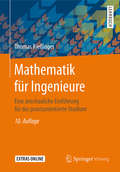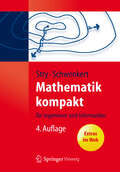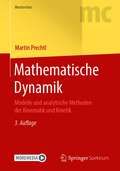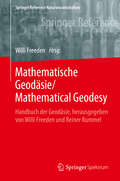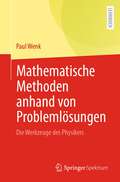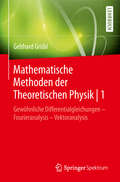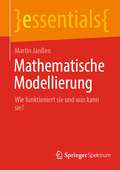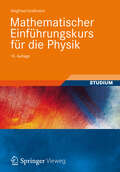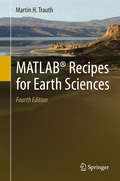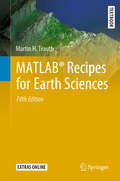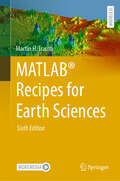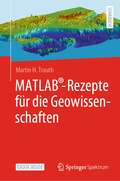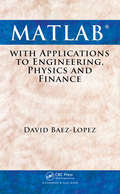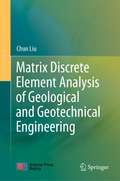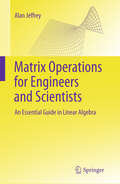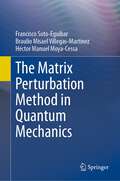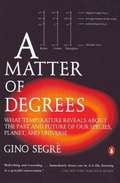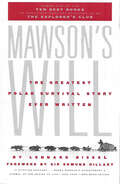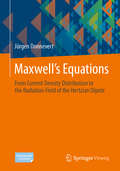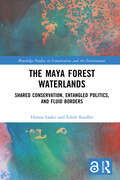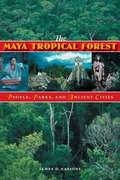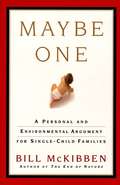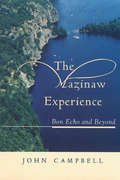- Table View
- List View
Mathematik für Ingenieure
by Thomas Rießinger"Mathematik in entspannter Atmosphäre" ist das Leitbild dieses leicht verständlichen Lehrbuchs. Im Erzählstil und mit vielen Beispielen beleuchtet der Autor nicht nur die Höhere Mathematik, sondern er stellt auch den Lehrstoff in Bezug zu den Anwendungen. Die gesamte für den Ingenieurstudenten wichtige Mathematik wird in einem Band behandelt. Dies gelingt durch Verzicht auf abstrakte Höhen und durch eine prüfungsgerechte Stoffauswahl, die sich streng an den Bedürfnissen des späteren Ingenieurs ausrichtet. Das Buch kann vorlesungsbegleitend oder zum Selbststudium eingesetzt werden. Die 159 Übungsaufgaben mit Lösungen unterstützen das Einüben des Lehrstoffs und sind im Band "Übungsaufgaben zur Mathematik für Ingenieure" ausführlich durchgerechnet.Der "Brückenkurs" beim Buch auf springer.com erleichtert Anfängern den Einstieg.
Mathematik kompakt
by Rainer Schwenkert Yvonne StryDas kompakte einbändige Werk bietet eine aktuelle Stoffauswahl mit Themen wie Wahrscheinlichkeitsrechnung und Statistik, dafür wird auf überflüssige Beweise verzichtet. Die Autoren präsentieren den gesamten Stoff in einem anschaulichen, aufgelockerten Stil - mit Zusammenfassungen und Verständnistests zu jedem Kapitel, Randnotizen für die schnelle Orientierung, Beispielen und Anwendungen sowie zahlreichen Übungsaufgaben mit Lösungen. Ergänzendes Material wie Folien und kommentierte Lösungen stehen im Internet zum Download bereit.
Mathematische Dynamik: Modelle und analytische Methoden der Kinematik und Kinetik (Masterclass)
by Martin PrechtlIn diesem Lehrbuch werden folgende Themengebiete abgedeckt: Kinematik, Massenpunkt- und Starrkörperkinetik, Mehrkörpersysteme und schwingungsfähige Systeme – einschließlich ausgewählter Fragestellungen der sogenannten Maschinendynamik. Dabei liegt der Fokus auf den analytischen Lösungsmethoden. Zudem wird die praktische Relevanz der Dynamik mit einem wissenschaftlich-theoretischen Fundament verknüpft. Alle hierfür nötigen Herleitungen sind im Text integriert und in ausführlicher Form erklärt. Um den Komplex der Dynamik zu erfassen, werden einfache Beispiele mit verschiedenen Ansätzen gerechnet und auf Vor-/Nachteile verglichen. Jene Aufgaben sind derart strukturiert, dass man die Vorgehensweise bei der Lösungsfindung anhand eingängiger Konstellationen leicht nachvollziehen kann – wie beispielsweise bei der Wahl eines zweckmäßigen Koordinatensystems. Folglich ist das Buch Grundlagenlektüre und Nachschlagewerk zugleich, für alle, die sich die Theorie technischer Bewegungsvorgänge erarbeiten wollen. Ein eigenes Übungskapitel mit „gemischten Arbeitspaketen“ rundet das Lehrbuch ab; für alle Aufgaben ist eine Lösungsvariante skizziert und ausführlich kommentiert. Zur Vertiefung der Eigenschaften ausgewählter mechanischer Systeme werden virtuelle Modelle mit dem kostenlosen Tool SimulationX angeboten: Videos geben dabei einen hilfreichen Überblick und Simulationen können von den LeserInnen selbst ausgeführt, modifiziert und weiterentwickelt werden. Diese interaktiven Beispiele bieten damit auch einen spielerischen Zugang zur Welt der Technischen Dynamik, außerdem absolviert man nebenbei einen kleinen Crash-Kurs in SimulationX.
Mathematische Geodäsie/Mathematical Geodesy: Handbuch der Geodäsie, herausgegeben von Willi Freeden und Reiner Rummel (Springer Reference Naturwissenschaften)
by Willi FreedenSelbstkonsistente Darstellung von Schlüssel- und Transfermethodologien vom Realitätsraum geodätischer Messungen und Beobachtungen in den Modellraum mathematischer Strukturen und Lösungen und zurück, neue Perspektiven und Forschungstrends im Bereich Mathematischer Geodäsie.
Mathematische Grundlagen für Umweltsystemwissenschaften: Einführung in die Differential- und Integralrechnung
by Marie Lisa Kogler Raven AdamProzesse in Umweltsystemen werden durch Größen beschrieben, die miteinander gekoppelt sind und so das Systemverhalten prägen. Diese Zusammenhänge können mittels Funktionen mathematisch beschrieben und verstanden werden.Das vorliegende Lehrbuch widmet sich anschaulich der Differential- und Integralrechnung und ist insbesondere für das Studium der Umweltsystemwissenschaften und vergleichbare anwendungsorientierte Studiengänge geeignet. Zahlreiche Skizzen, Bilder und detailreiche Erläuterungen dienen der Visualisierung und Veranschaulichung. Eine große Menge an Beispielen mit ausführlich dargestellten Lösungswegen fördert sowohl methodische Kenntnisse als auch ein Verständnis für Anwendbarkeit. Verschiedene Anwendungsbeispiele zu ausgewählten Themen dienen dazu, die theoretischen Kenntnisse in der Praxis anwenden zu können. Die Themengebiete umfassen Funktionen, Folgen und Reihen, Grenzwerte, Stetigkeit, Grundlagen der Differential- und Integralrechnung, mehrdimensionale Funktionen und deren Ableitungen, Taylor-Entwicklung und Koordinatensysteme. Jedes Kapitel beinhaltet Beispielkataloge zum Selbststudium. Die umweltsystemwissenschaftlichen Beispiele reichen von Räuber-Beute-Systemen, wirtschaftlich nachhaltiger Produktion und dem Wärmeinseleffekt bis hin zu biologischen Auswirkungen von Giftstoffen.
Mathematische Methoden anhand von Problemlösungen: Die Werkzeuge des Physikers
by Paul WenkDie mathematischen Sätze gelernt? Die Formeln auch? Nun fehlt noch das Wichtigste: die Anwendung des Gelernten auf Probleme, die über ein einfaches Beispiel hinausgehen. Die mathematischen Werkzeuge, die man sich in jedem naturwissenschaftlichen Studium aneignet, lernt man schließlich erst bei der Bearbeitung von Problemen wirklich kennen. Jedoch kann das Lernen oft frustrierend werden, wenn man die Lösung nicht findet, die Lektüre diese als trivial abtut oder nur schlicht durch eine nackte Zahl ohne erläuternden Kommentar angibt.Das vorliegende Lehrbuch macht die Lesenden mit zentralen mathematischen Werkzeugen für den Physiker vertraut. Dabei werden wichtige Standardaufgaben sowie physikalische Problemstellungen ausführlich gelöst und parallel dazu die Lösungswege diskutiert. Der Schwerpunkt liegt insbesondere auf der Verknüpfung der verschiedenen Aufgaben, und zwar unabhängig vom Schwierigkeitsgrad, so dass das Lösen immer komplexerer Aufgaben schrittweise erleichtert wird. Infolgedessen sind die Lösungen keine bloße Ergänzung, sondern ein zentraler Bestandteil dieses Lehrbuchs.
Mathematische Methoden der Theoretischen Physik | 1: Gewöhnliche Differentialgleichungen – Fourieranalysis - Vektoranalysis
by Gebhard GrüblDas vorliegende Buch behandelt die wichtigsten mathematischen Themen der Vorlesungen über Theoretische Physik. Es ergänzt damit die mathematischen Grundlagen, die Studierende der Physik im Rahmen der Vorlesungen über Analysis und Lineare Algebra vermittelt bekommen. Der Autor verzichtet dabei zwar vielfach auf ausführliche Beweise, nicht aber auf eine präzise Formulierung der Sachverhalte. Zahlreiche physikalische Beispiele sollen ein gründliches Verständnis der mathematischen Zusammenhänge befördern und deren Bedeutung für unser Naturverständnis erschließen. Eine Sammlung von Aufgaben am Ende des jeweiligen Kapitels bietet den Leserinnen und Lesern Gelegenheit zur Übung. Der Inhalt dieses Teils deckt die gewöhnlichen Differentialgleichungen, Fourieranalysis und koordinatenfreie Differentialrechnung in Vektorräumen ab und begleitet mathematisch so die Theorievorlesungen zur Mechanik und Elektrodynamik. Das Buch bietet dabei nicht nur die notwendigen Grundlagen, sondern auch vertiefende Themen, die über den regulären Kanon hinausgehen oder eine konkrete Anwendung des Behandelten aufzeigen. Für eine effiziente Verwendung sind diese Kapitel klar mit einem Stern gekennzeichnet und können damit beim ersten Lesen übersprungen werden. Somit kann dieses Werk begleitend zu den Vorlesungen eingesetzt werden, aber auch darüber hinaus zur eigenständigen Verfestigung quer über verschiedene Themenbereiche hinweg anleiten.
Mathematische Modellierung: Wie funktioniert sie und was kann sie? (essentials)
by Martin JanßenMathematische Modellierung (MM) dient als Planungswerkzeug für Entscheidungen, von denen wir alle zunehmend betroffen sind. Über das Vorgehen und die Aussagekraft von MM ist daher ein grundlegendes Verständnis auch ohne akademische Vorbildung wünschenswert. MM benötigt zwei wesentliche Elemente: Das Auffinden relevanter Einflussgrößen und das Auffinden einer kleinschrittigen Regel, die den Ablauf von Szenarien schrittweise erfasst. Im Text werden prototypische Modelle vorgestellt, die weite Anwendungsbereiche haben. Die Grenzen vom MM ergeben sich aus unvermeidbaren Beschränkungen in der Genauigkeit und sie führen zu einer Verzweigung von Modellen in vernetzte Modellsysteme.
Mathematischer Einführungskurs für die Physik
by Siegfried GroßmannStudierende, die ein Physikstudium aufnehmen, brauchen zu Beginn vor allem eines: mathematische Grundkenntnisse. Da es sich hierbei zunächst um einen relativ beschränkten und charakteristischen Ausschnitt aus der Mathematik handelt, werden die benötigten Kompetenzen vor allem im Rahmen von Tutorien oder Arbeitsgruppen vermittelt. Dieser Einführungskurs soll Studierenden im ersten Semester helfen, die Inhalte dieser Veranstaltungen zu vertiefen und möglichst rechtzeitig die Fähigkeiten zu erwerben, die ein erfolgreiches Physikstudium garantieren.
MATLAB® Recipes for Earth Sciences
by Martin H. TrauthMATLAB® is used for a wide range of applications in geosciences, such as image processing in remote sensing, the generation and processing of digital elevation models and the analysis of time series. This book introduces methods of data analysis in geosciences using MATLAB, such as basic statistics for univariate, bivariate and multivariate datasets, time-series analysis, signal processing, the analysis of spatial and directional data and image analysis. The revised and updated Fourth Edition includes sixteen new sections and most chapters have greatly been expanded so that they now include a step by step discussion of all methods before demonstrating the methods with MATLAB functions. New sections include: Array Manipulation; Control Flow; Creating Graphical User Interfaces; Hypothesis Testing; Kolmogorov-Smirnov Test; Mann-Whitney Test; Ansari-Bradley Test; Detecting Abrupt Transitions in Time Series; Exporting 3D Graphics to Create Interactive Documents; Importing, Processing and Exporting LANDSAT Images; Importing and Georeferencing TERRA ASTER Images; Processing and Exporting EO-1 Hyperion Images; Image Enhancement; Correction and Rectification; Shape-Based Object Detection in Images; Discriminant Analysis; and Multiple Linear Regression. The text includes numerous examples demonstrating how MATLAB can be used on data sets from earth sciences. The book's supplementary electronic material (available online through Springer Link) includes recipes that include all the MATLAB commands featured in the book and the example data.
MATLAB® Recipes for Earth Sciences: Matlab® And Design Recipes For Earth Sciences (Springer Textbooks in Earth Sciences, Geography and Environment)
by Martin H. TrauthMATLAB® is used in a wide range of geoscientific applications, e.g. for image processing in remote sensing, for creating and processing digital elevation models, and for analyzing time series. This book introduces readers to MATLAB-based data analysis methods used in the geosciences, including basic statistics for univariate, bivariate and multivariate datasets, time-series analysis, signal processing, the analysis of spatial and directional data, and image analysis. The revised and updated Fifth Edition includes seven new sections, and the majority of the chapters have been rewritten and significantly expanded. New sections include error analysis, the problem of classical linear regression of log-transformed data, aligning stratigraphic sequences, the Normalized Difference Vegetation Index, Aitchison’s log-ratio transformation, graphical representation of spherical data, and statistics of spherical data. The book also includes numerous examples demonstrating how MATLAB can be used on datasets from the earth sciences. The supplementary electronic material (available online through SpringerLink) contains recipes that include all the MATLAB commands featured in the book and the sample data.
MATLAB® Recipes for Earth Sciences (Springer Textbooks in Earth Sciences, Geography and Environment)
by Martin H. TrauthMATLAB® is used in a wide range of geoscientific applications, such as for image processing in remote sensing, for generating and processing digital elevation models, and for analyzing time series. This book introduces methods of data analysis in the earth sciences using MATLAB, such as basic statistics for univariate, bivariate, and multivariate data sets, time series analysis, signal processing, spatial and directional data analysis, and image analysis. The text includes numerous examples demonstrating how MATLAB can be used on data sets from the earth sciences. The supplementary electronic material (available online through Springer Link) contains recipes that include all the MATLAB commands featured in the book and example data.
MATLAB®-Rezepte für die Geowissenschaften
by Martin H. TrauthTrauth, Martin H.MATLAB® - Rezepte für Geowissenschaften, 1. deutschsprachige Auflage, basierend auf der korrigierten 5. englischsprachigen AuflageMATLAB® wird in einer Vielzahl von geowissenschaftlichen Anwendungen eingesetzt, z.B. zur Bildverarbeitung in der Fernerkundung, zur Erzeugung und Verarbeitung digitaler Höhenmodelle und zur Analyse von Zeitreihen. Dieses Buch führt in Methoden der Datenanalyse in den Geowissenschaften mit MATLAB ein, wie z.B. grundlegende Statistik für univariate, bivariate und multivariate Datensätze, Zeitreihenanalyse, Signalverarbeitung, die Analyse räumlicher und gerichteter Daten und Bildanalyse. Der Text enthält zahlreiche Beispiele, die zeigen, wie MATLAB auf Datensätze aus den Geowissenschaften angewendet werden kann. Das ergänzende elektronische Material des Buches (online verfügbar über Springer Link) enthält Rezepte, die alle im Buch vorgestellten MATLAB-Befehle und die Beispieldaten enthalten. Das Buch soll Student:innen, Doktorand:innen, Postdoktorand:innen und Fachleuten helfen, schnelle Lösungen für gängige Datenanalyseprobleme in den Geowissenschaften zu finden.SystemanforderungenBenutzer:innen dieses Buches benötigen die MATLAB®-Software, die für Windows, macOS und Linux verfügbar ist. Die M-Files und Beispieldaten, die online über Springer Link verfügbar sind, sollten auf allen Plattformen laufen, ohne dass eine Modifikation erforderlich ist. Für diese Ausgabe haben wir MATLAB Version 9.11 (Release 2021b), die Bioinformatics Toolbox Version 4.15.2, die Image Processing Toolbox Version 11.4, die Mapping Toolbox Version 5.2, die Signal Processing Toolbox Version 8.7, Simulink 3D Animation Version 9.3, die Statistics and Machine Learning Toolbox Version 12.2 und die Wavelet Toolbox Version 6.0 verwendet.
MATLAB with Applications to Engineering, Physics and Finance
by null David Baez-LopezMaster the tools of MATLAB through hands-on examplesShows How to Solve Math Problems Using MATLABThe mathematical software MATLAB integrates computation, visualization, and programming to produce a powerful tool for a number of different tasks in mathematics. Focusing on the MATLAB toolboxes especially dedicated to science, finance, and engineering
Matrix Discrete Element Analysis of Geological and Geotechnical Engineering
by Chun LiuThis book introduces the basic structure, modeling methods, numerical calculation processes, post-processing, and system functions of MatDEM, which applies the basic principles and algorithm of the discrete element method. The discrete element method can effectively simulate the discontinuity, inhomogeneity, and large deformation damage of rock and soil. It is widely used in both research and industry. Based on the innovative matrix discrete element computing method, the author developed the high-performance discrete element software MatDEM from scratch, which can handle millions of elements in discrete element numerical simulations. This book also presents several examples of applications in geological and geotechnical engineering, including basic geotechnical engineering problems, discrete element tests, three dimensional landslides, and dynamic and multi-field coupling functions. Teaching videos and the relevant software can be accessed on the MATDEM website (http://matdem.com). The book serves as a useful reference for research and engineering staff, undergraduates, and postgraduates who work in the fields of geology, geotechnical, water conservancy, civil engineering, mining, and physics.
Matrix Operations for Engineers and Scientists
by Alan JeffreyEngineers and scientists need to have an introduction to the basics of linear algebra in a context they understand. Computer algebra systems make the manipulation of matrices and the determination of their properties a simple matter, and in practical applications such software is often essential. However, using this tool when learning about matrices, without first gaining a proper understanding of the underlying theory, limits the ability to use matrices and to apply them to new problems. This book explains matrices in the detail required by engineering or science students, and it discusses linear systems of ordinary differential equations. These students require a straightforward introduction to linear algebra illustrated by applications to which they can relate. It caters of the needs of undergraduate engineers in all disciplines, and provides considerable detail where it is likely to be helpful. According to the author the best way to understand the theory of matrices is by working simple exercises designed to emphasize the theory, that at the same time avoid distractions caused by unnecessary numerical calculations. Hence, examples and exercises in this book have been constructed in such a way that wherever calculations are necessary they are straightforward. For example, when a characteristic equation occurs, its roots (the eigenvalues of a matrix) can be found by inspection. The author of this book is Alan Jeffrey, Emeritus Professor of mathematics at the University of Newcastle upon Tyne. He has given courses on engineering mathematics at UK and US Universities.
The Matrix Perturbation Method in Quantum Mechanics
by Francisco Soto-Eguibar Braulio Misael Villegas-Martínez Héctor Manuel Moya-CessaThis book provides an alternative approach to time-independent perturbation theory in non-relativistic quantum mechanics. It allows easy application to any initial condition because it is based on an approximation to the evolution operator and may also be used on unitary evolution operators for the unperturbed Hamiltonian in the case where the eigenvalues cannot be found. This flexibility sets it apart from conventional perturbation theory. The matrix perturbation method also gives new theoretical insights; for example, it provides corrections to the energy and wave function in one operation. Another notable highlight is the facility to readily derive a general expression for the normalization constant at m-th order, a significant difference between the approach within and those already in the literature. Another unique aspect of the matrix perturbation method is that it can be extended directly to the Lindblad master equation. The first and second-order corrections are obtained for this equation and the method is generalized for higher orders. An alternative form of the Dyson series, in matrix form instead of integral form, is also obtained. Throughout the book, several benchmark examples and practical applications underscore the potential, accuracy and good performance of this novel approach. Moreover, the method's applicability extends to some specific time-dependent Hamiltonians. This book represents a valuable addition to the literature on perturbation theory in quantum mechanics and is accessible to students and researchers alike.
A Matter of Degrees
by Gino SegreIn a wonderful synthesis of science, history, and imagination, Gino Segrè, an internationally renowned theoretical physicist, embarks on a wide-ranging exploration of how the fundamental scientific concept of temperature is bound up with the very essence of both life and matter. Why is the internal temperature of most mammals fixed near 98.6°? How do geologists use temperature to track the history of our planet? Why is the quest for absolute zero and its quantum mechanical significance the key to understanding superconductivity? And what can we learn from neutrinos, the subatomic "messages from the sun" that may hold the key to understanding the birth-and death-of our solar system? In answering these and hundreds of other temperature-sensitive questions, Segrè presents an uncanny view of the world around us.
Mawson's Will: The Greatest Survival Story Ever Written
by Sir Edmund Hillary Lennard BickelMAWSON'S WILL is the dramatic story of what Sir Edmund Hillary calls "the most outstanding solo journey ever recorded in Antarctic history." For weeks in Antarctica, Douglas Mawson faced some of the most daunting conditions ever known to man: blistering wind, snow, and cold; loss of his companion, his dogs and supplies, the skin on his hands and the soles of his feet; thirst, starvation, disease, snowblindness - and he survived. Sir Douglas Mawson is remembered as the young Australian who would not go to the South Pole with Robert Scott in 1911, choosing instead to lead his own expedition on the less glamorous mission of charting nearly 1,500 miles of Antarctic coastline and claiming its resources for the British Crown. His party of three set out through the mountains across glaciers in 60-mile-per-hour winds. Six weeks and 320 miles out, one man fell into a crevasse, along with the tent, most of the equipment, all of the dogs' food, and all except a week's supply of the men's provisions.Mawson's Will is the unforgettable story of one man's ingenious practicality and unbreakable spirit and how he continued his meticulous scientific observations even in the face of death. When the expedition was over, Mawson had added more territory to the Antarctic map than anyone else of his time. Thanks to Bickel's moving account, Mawson can be remembered for the vision and dedication that make him one of the world's great explorers."A riveting account . . . makes Mawson's achievement a symbol of the desire to live." -- The New York Times Book Review"A powerful reading experience." -- Publishers WeeklyFrom the Trade Paperback edition.
Maxwell´s Equations: From Current Density Distribution to the Radiation Field of the Hertzian Dipole
by Jürgen DonnevertThis book focuses on the derivation and solution of Maxwell’s equations. The stations along the way include the laws of potential and current density distribution, as well as the laws of electrostatics and stationary magnetic fields. The book is chiefly intended for students of electrical engineering, information technology, and physics; the goal is to prepare them for courses on Electromagnetic Field Theory (EFT). Building on what they have learned in advanced physics and mathematics courses at secondary school or technical college, it is intended to accompany university-level EFT courses. Particular importance is attached to detailed explanations in text form, combined with a wealth of illustrations. All formulas are derived step by step.
The Maya Forest Waterlands: Shared Conservation, Entangled Politics, and Fluid Borders (Routledge Studies in Conservation and the Environment)
by null Hanna Laako null Edith KaufferThis book examines the entanglements and blurred edges of nature conservation and geopolitical relations in the borderlands of the trinational Maya Forest.Maya Forest is an umbrella term for transboundary conservation developed by scientists and conservationists in the 1990s to protect the threatened rainforest in the borderlands of Mexico, Belize, and Guatemala. Currently, the Maya Forest is a biodiversity hotspot composed of a network of protected areas and heritage sites. However, issues related to water, land, and forests have often been treated as separate political units, and not as part of the same history. Written by two authors with decades of hands-on experience in this region, this book sheds light on the complex dynamics by which conservation and natural resource management geopolitically shape borderlands such as the Maya Forest. The book introduces the novel concept of forest waterlands as borderlands and fluid edges, which are now subject to concern by conservationists. These are entangled spaces in which conservation, peoples, and politics interact, connect, and disconnect with the nexus of waters, forests, and lands. The book sheds light on the building and mapping of the Maya Forest ecoregion, with particular attention to water as an often neglected, but unifying element. It showcases how the Maya Forest is a distinct region characterized by transformations entangled with the Maya, trails of biological stations, the shared history of chicleros (chewing-gum hunters), fluid international rivers and transboundary basins, and various geopolitical discrepancies. It offers a contemporary glimpse into the Maya Forest’s intertwined bio- and geopolitics, which urge us to rethink borders and boundaries.This book will be of great interest to students and scholars of nature conservation, global environmental politics, geopolitics, borderlands, international relations, and natural resource management.
The Maya Tropical Forest: People, Parks, and Ancient Cities
by James D. NationsThe Maya Tropical Forest, which occupies the lowlands of southern Mexico, Guatemala, and Belize, is the closest rainforest to the United States and one of the most popular tourist destinations in the Western Hemisphere. It has been home to the Maya peoples for nearly four millennia, starting around 1800 BC. Ancient cities in the rainforest such as Palenque, Yaxchilan, Tikal, and Caracol draw thousands of tourists and scholars seeking to learn more about the prehistoric Maya. Their contemporary descendants, the modern Maya, utilize the forest's natural resources in village life and international trade, while striving to protect their homeland from deforestation and environmental degradation. Writing for both visitors and conservationists, James Nations tells the fascinating story of how ancient and modern Maya peoples have used and guarded the rich natural resources of the Maya Tropical Forest. He opens with a natural history that profiles the forest's significant animals and plants. Nations then describes the Maya peoples, biological preserves, and major archaeological sites in Mexico, Guatemala, and Belize. Drawing on more than twenty-five years of conservation work in the Maya Tropical Forest, Nations tells first-hand stories of the creation of national parks and other protected areas to safeguard the region's natural resources and archaeological heritage. He concludes with an expert assessment of the forest's future in which he calls for expanded archaeological tourism to create an ecologically sustainable economic base for the region.
Maybe One
by Bill MckibbenFrom the groundbreaking, bestselling author of The End of Nature, a controversial and provocative book arguing that to help the planet we should begin to voluntarily limit our numbers. Bill McKibben's books and essays on our environment -- physical and spiritual -- have shaped and spurred debate since The End of Nature was published in 1989. Then, he sounded one of the earliest alarms about global warming; the decade of science since has proved his prescience. Now, in Maybe One, he takes on the most controversial of environmental problems -- population. We live in a unique and dangerous time, he asserts, when the planet's limits are being tested and voluntary reductions in American childbearing could make a crucial difference. The father of a single child himself, McKibben maintains that bringing one, and no more than one, child into this world will hurt neither your family nor our nation -- indeed, it can be an optimistic step toward the future. Maybe One is not just an environmental argument but a highly personal and philosophical one. McKibben cites new and extensive research about the developmental strengths of only children; he finds that single kids are not spoiled, weird, selfish, or asocial, but pretty much the same as everyone else. McKibben recognizes that the transition to a stable population size won't be easy or pain-free but ultimately is inevitable. Maybe One provides the basis for provocative, powerful thought and discussion that will influence our thinking for decades to come.
The Mazinaw Experience: Bon Echo and Beyond
by John CampbellThe Mazinaw, a place of striking natural beauty, is famous for Bon Echo Rock, a massive sheer cliff, dropping into one of Ontario’s deepest lakes. The Mazinaw Experience traces the presence of human habitation on the shores of the Mazinaw from its earliest beginnings to the present, from the nomadic Aboriginal people who believed the cliff top to be a sacred place and the rugged lumbermen whose entrepreneurial zeal cleared out the mighty pine, to the settlers who struggled to create new lives for their families. Mini-profiles of personalities such as Johnny Bey and Billa Flint, along with stories involving colonization roads, the settlement towns, the mining and the coming of the railway, provide insights into the Mazinaw area of today. The memory of Bon Echo Inn lives on in Bon Echo Park, as does the legacy of Flora MacDonald and her son Merrill Denison. Today, the Mazinaw area continues to grow in popularity.
